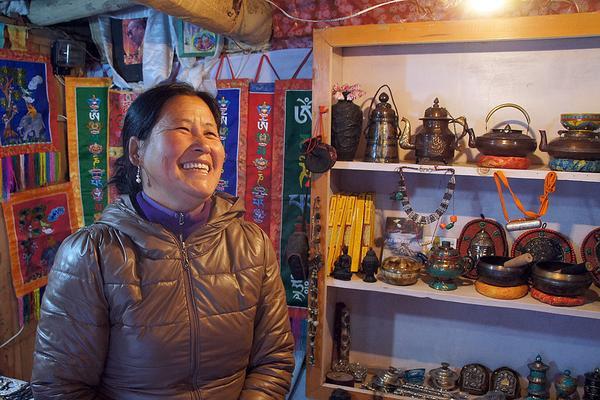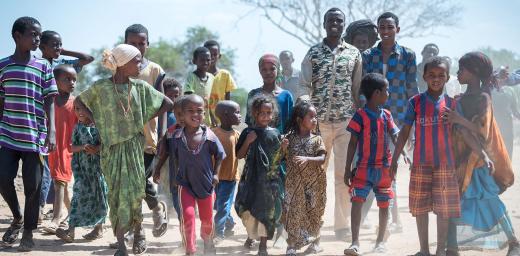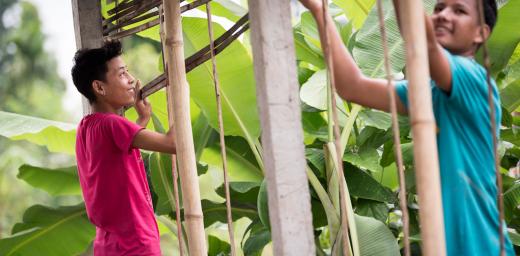Having an identity, having a future

Dolma, a Tibetan refugee, runs a successful souvenir shop, with support from the LWF. Photo: C. Kastner
"Of course I want to go back home. I miss my country."
« Om mani padmi om »… The old woman mumbles while touching the prayer wheels outside the stupa- or gomba- in the Tishaling Tibetan Settlement near Pokhara, Nepal. There are four Tibetan refugee settlements in Pokhara. Tishaling is a small village, home to 120 households with 740 Tibetans up to the third generation.
Khando, the old woman, like many elderly women does her rounds every day. 40 times she circles the stupa in the morning, 20 times in the evening, to pray for the Dalai Lama, for happiness and peace in the world and for her own wishes – in that order. She came to Nepal in 1964 as a 18-year-old girl. In Tibet, her family were nomads, they used to herd goats and yaks in the Tibetan highlands. “Of couse I want to go back” she says. “I miss my country, the place where I lived.” Now her brothers and sisters live in Kathmandu, where the Tibetans are part of the business elite.
Tishaling also is a place of business. In souvenir shops the inhabitants sell homemade jewelry, hand woven fabric and religious art. The Lutheran World Federation (LWF) assists two local NGOs in creating sustainable livelihoods. The settlement has a school, a health clinic and a monastery, where young men and boys of all ages can be seen in their red robes. Many families still follow the Tibetan tradition of sending one male child to become a monk.
It is surprising that with all the evidence of a rich cultural heritage, “identity” is the main issue named by the people in the settlemnt. Sonam, a young woman of 26, has been born in Nepal. Like many others she knows Tibet only from books and the stories her late mother and her father told her. Still she is set on going “back home” as soon as the “Tibetan issue”, as people call it, has been resolved.
“It is difficult to get a job” she explains. As the Nepali government officially does not grant citizenship to the Tibetan refugees, Sonam who holds a BA in IT could never find employment in the public sector. Her dream is to start an NGO for women and youth. “In Tibet I would be allowed to vote, I could buy land and build a house” she says.
Going back home to her means having a future.
Opportunities for young people
To the Tibetans in Marpha settlement, a five-day trek away from Pokhara, going back home is no longer an option.
Marpha is situated at the Thak Kola river, at 2670 m in a highland region inhabited by the Buddhist Thakali people. The town is famous for apple and apricot products, from dried slices to brandy, and its Tibetan souvenir shops. Apple orchards and farming are part of the LWF’s work for the people who fled Tibet in the 1960’s and found a new home in Nepal.
The Tibetan refugee settlement has a primary school, a health clinic and garden plots for each family. Solar cookers catch the visitor’s attention in the otherwise very traditional streets. Garlands of prayer flags flutter everywhere: On the suspension bridge leading to the settlement, over houses and streets and around the gumpa, the traditional temple.
LWF has supported the settlement in various ways. Due to LWF donations, the river which undercuts the pathway to the settlement every spring has been reined in with fortifications on the river bank. LWF did vocational training for the youth, helped to make the soil fertile in the orchards and fields and worked in capacity building so the camp could raise its own funds. Like in the other refugee camps, LWF works through community-based organizations and builds their capacities on the way.
LWF is the only NGO assisting in the camp. “They have contributed a lot”, camp manager Norbu Phuntsok says. Also, LWF sponsored a guest house. While it is still very basic, Mr Phuntsok hopes that the guesthouse in the Tibetan settlement will attract trekkers in the future. Because creating sustainable livelihoods is not just about money for community structures.
Though Tibetan refugees have well-established structures in organizing their exile, and are supported with donations from all over the world, refugee settlements hold little attraction to the young people of the community. “They want to go abroad, to Europe and the USA,” camp manager Phuntsok says. In Nepal, Tibetan refugees are allowed to move freely, unlike the refugees in many other countries.
Education opportunities lead the young people away from the settlement, first to high school in Pokhara, then to graduation in Kathmandu. For university studies, many go to India. There is little temptation to come back to the small town of Marpha with the cold winds blowing upstream in the morning and downstream at night and to do agricultural work. The settlement was connected to a telephone line only two years ago.
Looking for education
“The young girls go to nursing school in India,” the camp manager gives an example. “Two of them have graduated so far, but when we asked them to come back and work in our health clinic, they said they had found jobs with good salaries there, and wanted to stay a little longer.”
Dolma is one of the few young people who have stayed. She runs a successful souvenir shop. Dolma has only two years of school, but her shop supports her elderly parents, her little girl and herself. Some of the traditional handwoven belts and scarfs are made by her mother, who still preserves Tibetan culture and a Tibetan lifestyle in her home.
“The local people do not do much handcrafts, so they also buy our products,” Dolma says. It is but one example of a successful interaction with the local community and a small enterprise, which might help the future of the settlement. “Initially, people stayed here because it is close to Tibet and they hoped to return,” Phuntsok says. “Now, we don’t feel as refugees anymore. This is our home.”




